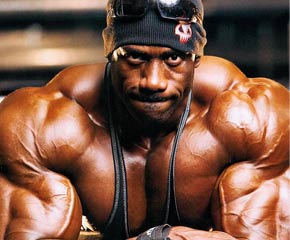- Like
- SHARE
- Digg
- Del
- Tumblr
- VKontakte
- Flattr
- Buffer
- Love This
- Save
- Odnoklassniki
- Meneame
- Blogger
- Amazon
- Yahoo Mail
- Gmail
- AOL
- Newsvine
- HackerNews
- Evernote
- MySpace
- Mail.ru
- Viadeo
- Line
- Comments
- Yummly
- SMS
- Viber
- Telegram
- JOIN
- Skype
- Facebook Messenger
- Kakao
- LiveJournal
- Yammer
- Edgar
- Fintel
- Mix
- Instapaper
- Copy Link
Weight Training Tips For Bodybuilders
 There isn’t a one size fits all bodybuilding weight training routine, but there are a few principles you should be following if you want to maximize your results.
There isn’t a one size fits all bodybuilding weight training routine, but there are a few principles you should be following if you want to maximize your results.
Muscular hypertrophy, an increase in muscle size due to the stress induced from strength training, is affected by a vast amount of factors such as workout frequency, intensity, and volume1.
In this article, I’ll teach you how to maximize muscle growth by incorporating periodization, progressive overload, and exercise variety into your weight training routine.
Periodization
Periodization is the concept of altering exercise variables such as volume, intensity, and frequency over time to optimize training progress. It allows us to train at a high intensity or volume with alternating periods of lower intensity or volume to facilitate recovery and to maximize performance.
In addition to, an article published in Journal of Strength and Conditioning Research concluded periodized programs can result in greater strength (1 Rep Max) gains than non-periodized multi-set and single-set programs2.
There are a number of different periodization models, the most popular probably being the original model of linear periodization. With linear periodization, every 4-6 weeks (phase) the reps/volume decrease while weight/intensity increases. e.g. phase one 15 reps with 100lbs, phase two 12 reps with 110lbs, phase three 10 reps with 120lbs, phase four 8 reps with 130lbs. However, this isn’t the most effective form of periodization.
Non-linear periodization focuses on changing the exercise variables on a more frequent basis e.g. Monday 15 reps with 100lbs, Wednesday 10 reps with 130lbs, Friday 5 reps with 160lbs. A study published by Journal of Strength and Conditioning Research concluded that for maximizing strength increases, daily intensity and volume variations were more effective than weekly variations3. Try changing up your weight/intensity and reps/volume each workout for maximum strength gains.
Progressive Overload
If you use the same amount of resistance for the same number of reps every workout, there will be no improvement beyond the point of which you’ve already reached1. Progressive overload is the concept of gradually increasing the demands of the body during exercise in order to increase strength and muscle mass1. Thus, meaning you need to continually lift more challenging weights to build more muscle mass.
Conversely, if the demands on your muscles are not at least maintained and are actually decreased, your muscles will become smaller and weaker1. This is why it is critical to include to progressive overload into your training program if you want to continue making progress. Try increasing resistance, reps, sets, training frequency, or the amount of exercises you do every 6-8 weeks to ensure muscular overload in your training program.
Exercise Variety
Bored of your workout, dreading squats today, not making any progress? Breaking plateaus and staying mentally focused are two benefits you’ll receive by adding a variety of exercises to your workout. Your muscles become very efficient at the exercises they are accustomed to doing and if performed with same intensity over a long period of time, eventually this adaption will lead to a plateau4.
However, by switching up the exercises or the order of exercises, the workout becomes more challenging which can stimulate muscle growth helping you break through a plateau. Exercise variety also helps you stay mentally focused by providing you with enjoyable new exercises and a psychological break from exercises you dread. Try doing your workout routine out of order, in reverse, using dumbbells instead of barbells, cables instead of machines, decline instead of incline, and vice versa to optimize training variety in your routine.
Start maximizing your results today by incorporating periodization, progressive overload, and exercise variety into your weight training routine.
Bodybuilding Weight Training Tips 101: References
- 1^ “ Fitness: The Complete Guide;” International Sports Sciences Association; 2007
- 2^ Journal of Strength and Conditioning Research ,2009 Dec;23(9):2437-42
- 3^Journal of Strength and Conditioning Research, 1999, 13(1), 82–89
- 4^Kraemer, William J.; Zatsiorsky, Vladimir M. (2006). Science and practice of strength training. Champaign, IL: Human Kinetics. p. 15.
About Julian Brown
JulianBrownTraining.com Julian is the co-owner of The Yard Fitness, an established fitness writer, a professional natural bodybuilder, a fitness & sport nutrition specialist, and a certified personal trainer. He began strength training at the young age of fourteen to improve his sports performance and hasn’t looked back since. Julian is a graduate of Grambling State University, ACE & NASM certified, and he has over a decade of personal experience in strength training.


Thanks for the idea Steve. I’ll be sure to keep that in mind :-)
Great article! Please consider a similar article with an eye on lifters over 50 years of age. Oh yeah there are still some of us!
Great article these articles are very informative and easy to understand.
Thank you for your nice comments.